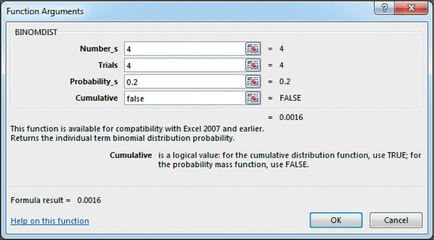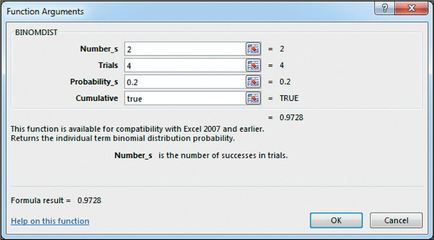STEP-BY-STEP TECHNOLOGY GUIDE: Finding Binomial Probabilities
For Example 18 (page 333):
TI-83/84
- Step 1 Press 2nd > DISTR (the VARS key).
- Step 2 Do one of (a) or (b):
- For individual binomial probabilities, highlight binompdf(, and press ENTER.
- For cumulative binomial probabilities, highlight binomcdf(, and press ENTER.
- Step 3 Enter the values for n, p, and K, separated by commas.
- Step 4 Press ENTER. (See Figures 9 and 10 on page 333.)
EXCEL
- Step 1 Select cell A1. Click the Insert Function icon fx.
- Step 2 In the Search for a function area, type BINOMDIST, click Go then OK.
- Step 3 For Number_s, enter the number of successes, K. For Trials, enter the sample size, n. For Probability_s, enter the probability of success, p.
- Step 4 Do one of (a) or (b):
- a. For individual binomial probabilities, next to Cumulative, enter false.
- b. For cumulative binomial probabilities, next to Cumulative, enter true.
- Step 5 Click OK. See Figures 16 and 17 for illustrations using Example 18.
 Figure 6.18: FIGURE 16 Example 18(a) using Excel.
Figure 6.18: FIGURE 16 Example 18(a) using Excel. Figure 6.19: FIGURE 17 Example 18(b) using Excel.
Figure 6.19: FIGURE 17 Example 18(b) using Excel.
337
MINITAB
- Step 1 Click Calc > Probability Distributions > Binomial…
- Step 2 Do one of (a) or (b):
- For individual binomial probabilities, select Probability and enter the number of trials n and probability of success p.
- For cumulative binomial probabilities, select Cumulative Probability and enter the number of trials n and probability of success p.
- Step 3 Select Input Constant, enter K and click OK.
SPSS
- Step 1 Input any one number into the first element of the spreadsheet. Rename the variable Prob.
- Step 2 Select Transform > Compute Variable…. In Target Variable, type Prob.
- Step 3 Do one of (a) or (b):
- For individual binomial probabilities, under Function group select PDF & Noncentral PDF. Under Functions and Special Variables, double-click Pdf.Binom. Replace the three question marks with the number of successes K, the number of trials n, and the probability of success p, in that order.
- For cumulative binomial probabilities, under Function group select CDF & Noncentral CDF. Under Functions and Special Variables, double-click Cdf.Binom. Replace the three question marks with the number of successes K, the number of trials n, and the probability of success p, in that order.
- Step 3 Click OK and OK. Minimize the output window.
JMP
- Step 1File > New > Data Table. Double-click the first element of Column 1. Right-click the header of Column 1. Select Column Info… and under Column Properties, choose Formula. Click Edit Formula.
- Step 2 Click Discrete Probability under Functions (grouped).Step 3 Do one of (a) or (b):
- For individual binomial probabilities, select Binomial Probability. Input probability of success p, number of trials n, and number of successes K, in that order.
- For cumulative binomial probabilities, select Binomial Distribution. Input probability of success p, number of trials n, and number of successes K, in that order.
- Step 3 Click OK twice.
CRUNCHIT!
- Step 1 Click Distribution calculator > Binomial.
- Step 2 For n, enter 4. For p, enter 0.2.
- Step 3 Do one of (a) or (b):
- For individual binomial probabilities, select = from the drop-down menu next to P(X, and enter 4 in the box beside it. Click Calculate. See Figure 12 for the result.
- For cumulative binomial probabilities, select ≤ from the drop-down menu, and enter 2. Click Calculate. See Figure 13 for the result.